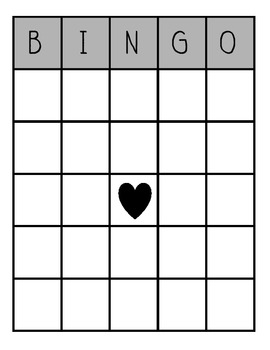As educators, we are constantly looking for new and engaging ways to teach our students. One fun and interactive activity that is always a hit in the classroom is Bingo. However, it can be time-consuming to create Bingo boards from scratch. Luckily, we have found a wonderful resource on Teachers Pay Teachers that provides a Blank Bingo Board for easy use in the classroom.
Blank Bingo Board by Katie Afanador
 With this resource, you can quickly and easily create custom Bingo boards tailored to your classroom curriculum. The board includes squares for you to fill in with your own specific content, ensuring that your students are learning exactly what they need to know.
With this resource, you can quickly and easily create custom Bingo boards tailored to your classroom curriculum. The board includes squares for you to fill in with your own specific content, ensuring that your students are learning exactly what they need to know.
Using Bingo as a teaching tool is not only fun, but it can also be incredibly effective. By playing Bingo, students are able to reinforce their knowledge of a particular topic while also engaging in a collaborative and social activity. The excitement of engaging with their peers in the game creates an immersive experience that they will carry with them long after class is over.
The Benefits of Using Bingo as a Teaching Tool
Bingo is a game that is both fun and easy to understand, making it an ideal choice for teaching young children. It is a versatile game that can be used in a variety of subjects, including math, language arts, science, and social studies.
Bingo can be an effective way to teach students new vocabulary words, spelling, or math skills. By introducing new concepts through the game, you can make learning more fun and engaging for your students. Additionally, it can be a great tool to use in reviewing material for a test or quiz.
Bingo can also be a great way to build camaraderie and teamwork among students. As they work together to achieve Bingo, they will learn to support and encourage one another, which can lead to stronger relationships and a more positive classroom environment.
How to Use the Blank Bingo Board by Katie Afanador
Using the Blank Bingo Board by Katie Afanador is simple and straightforward. To get started, simply print out the board and fill in the squares with your own content. You can choose to customize the board to fit any subject or topic that you are teaching.
Once the Bingo boards are completed, distribute them to your students along with Bingo chips (or any small object that can be used as a marker). You can then either call out the Bingo squares or use a deck of cards with corresponding squares to be drawn.
The first student to achieve Bingo (either vertically, horizontally, or diagonally) wins the game. However, you can also choose to play Blackout Bingo, which requires students to fill in all of the squares on their board before winning.
Conclusion
Bingo is a classic game that has stood the test of time, and it is also an effective and fun teaching tool. By using the Blank Bingo Board by Katie Afanador, you can easily create customized Bingo boards that will engage your students and reinforce the concepts that you are teaching.
So why not give it a try in your classroom? Your students will thank you for making learning both fun and effective!